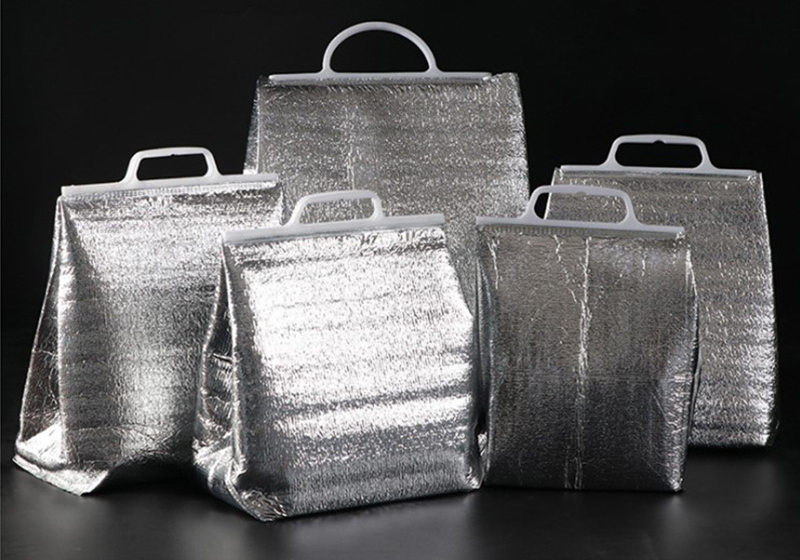Get Free Sample
Efficient Insulation: Made with high-quality insulation materials, our disposable insulated bags ensure that beverages maintain their ideal temperature for an extended period, satisfying customers' demand for hot drinks.
Smart Divided Design: The unique divided layer design guarantees that each cup of beverage remains separate, unaffected by external temperatures, providing an increased drinking experience.
User-Friendly Design: Lightweight and easy to carry, our bags feature reliable sealing at the opening, making them suitable for various shopping and takeout scenarios.


Jiangsu Marrot Biotechnology Co., Ltd. is well-known China Disposable Insulated Bags Manufacturers and Disposable Insulated Bags factory, established in 2014 as a comprehensive packaging material service provider, specializing in mold development, design, production, and domestic and international trade. Currently, our company operates in a 20,000-square-meter facility with a specialized production team of over 100 professionals. We possess over 80 pieces of equipment, including high-speed flexographic printers, high-speed die-cutting and punching machines, high-speed paper cup and bowl machines, and fully automated packaging machines. Our production workshop adheres to high cleanliness standards and is BRC-certified, ensuring food packaging safety.
Our company's product positioning is in the mid-to-high-end customizations for chain restaurants. With nearly a decade of dedicated efforts, we have gained the favor of numerous brands in channels such as Chinese cuisine, tea shops, coffee shops, and cinemas.
We have our own custom print Disposable Insulated Bags factory. Our production workshop maintains a high standard of cleanliness and meets the requirements of BRC certification. This means that we strictly adhere to hygiene and safety standards for food packaging, providing customers with safe and reliable food packaging products.
From Forest to Fast Food: The Making of the Bowl The simple, sturdy container th...
View MoreThe modern takeout experience demands two things: convenience and reliability. I...
View MoreThe daily ritual of grabbing a hot cup of coffee is an integral part of modern l...
View MoreDisposable straws have been an ubiquitous item in daily life for decades, enhanc...
View MoreDisposable Cup Lids are an indispensable element of the modern, on-the-go bevera...
View MoreInsulation Material: Disposable insulated bags typically use materials like foam, bubble wrap, or insulated liners to create a barrier between the contents and the outside environment. The quality and type of insulation material significantly impact how well the bag can retain temperature. For example, foam provides better insulation than thinner materials like bubble wrap, which may offer minimal thermal resistance.
Thickness: The thickness of the insulation layer plays a crucial role in temperature retention. Thicker insulation generally means better thermal resistance and longer-lasting temperature control. Thinner bags may be less effective, especially in extreme temperatures or over extended periods.
Sealing Mechanism: The method used to seal the bag affects how well it traps heat or cold inside. Disposable insulated bags often use zippers, Velcro closures, or adhesive strips to seal the opening. A secure and tight seal helps minimize temperature exchange between the inside and outside environments, enhancing the bag's effectiveness.
Duration of Use: Disposable insulated bags are typically designed for short-term use, such as transporting perishable goods from a store to home. They are generally effective at maintaining temperature for several hours, such as during grocery shopping or meal delivery. However, their effectiveness may decline over time compared to reusable insulated bags, which are designed for longer-term temperature retention.
Environmental Conditions: External factors such as ambient temperature and exposure to sunlight can impact the performance of disposable insulated bags. In hot weather, the insulation must work harder to keep contents cool, while in cold weather, it must prevent heat loss. Extreme temperatures outside the bag can affect its ability to maintain the desired internal temperature.
Size and Contents: The size of the bag and how it's filled can affect its ability to maintain temperature. Larger bags with more empty space or bags holding larger volumes of items may experience more temperature loss compared to smaller, tightly packed bags. Properly filling the bag and minimizing empty space can help optimize temperature retention.
Comparative Effectiveness: While disposable insulated bags offer convenience and affordability for short-term use, they may not match the performance of reusable insulated bags designed for durability and repeated use. Reusable bags often feature higher-quality insulation and more robust sealing mechanisms, making them more effective for extended periods and reducing environmental impact through repeated use.